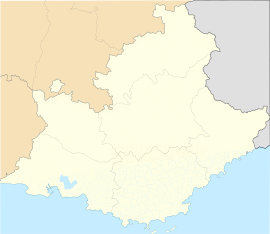La Fare-les-Oliviers
La Fare-les-Oliviers
La Fara deis Oliviers (Occitan) | |
|---|---|
 Sainte-Rosalie chapel | |
 Coat of arms | |
show Location of La Fare-les-Oliviers | |
 La Fare-les-Oliviers | |
| Coordinates: 43°33′09″N 5°11′42″E / 43.5525°N 5.195°ECoordinates: 43°33′09″N 5°11′42″E / 43.5525°N 5.195°E | |
| Country | France |
| Region | Provence-Alpes-Côte d'Azur |
| Department | Bouches-du-Rhône |
| Arrondissement | Aix-en-Provence |
| Canton | Berre-l'Étang |
| Intercommunality | Aix-Marseille-Provence |
| Government | |
| • Mayor (2020–2026) | Olivier Guirou[1] |
| Area 1 | 13.98 km2 (5.40 sq mi) |
| Population (Jan. 2018)[2] | 8,666 |
| • Density | 620/km2 (1,600/sq mi) |
| Time zone | UTC+01:00 (CET) |
| • Summer (DST) | UTC+02:00 (CEST) |
| INSEE/Postal code | 13037 /13580 |
| Elevation | 27–223 m (89–732 ft) (avg. 53 m or 174 ft) |
| 1 French Land Register data, which excludes lakes, ponds, glaciers > 1 km2 (0.386 sq mi or 247 acres) and river estuaries. | |
La Fare-les-Oliviers (French pronunciation: [la faʁ le.z‿ɔlivje]; Occitan: La Fara deis Oliviers) is a commune in the Bouches-du-Rhône department in the Provence-Alpes-Côte d'Azur region in Southern France. Located in the Aix-Marseille-Provence Metropolis, it had a population of 8,666 in 2018.
History[]
A castle, Castellas, was built in the 10th century.
In the 18th century, a pavilion was built in the centre of the village.
Geography[]
The commune is situated 20 km (12.4 mi) to the west of Aix-en-Provence and 13 km (8 mi) to the southeast of Salon-de-Provence.
Demographics[]
|
|
See also[]
References[]
- ^ "Répertoire national des élus: les maires". data.gouv.fr, Plateforme ouverte des données publiques françaises (in French). 2 December 2020. Retrieved 7 December 2020.
- ^ "Populations légales 2018". INSEE. 28 December 2020.
External links[]
| Wikimedia Commons has media related to La Fare-les-Oliviers. |
Categories:
- Communes of Bouches-du-Rhône


